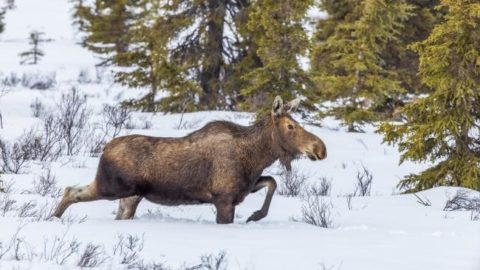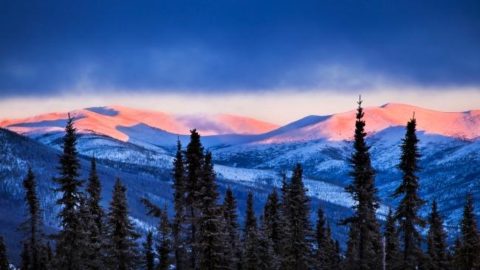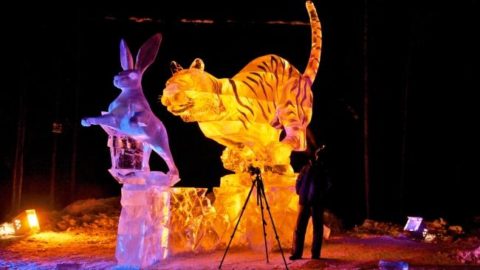Fairbanks is Alaska’s best place to see the Northern Lights.

Shivering in the frigid Alaskan night, I stood in deep snow on a hilltop outside Fairbanks and scanned the black sky. I had travelled north, far north, to the interior of Alaska, gambling that I would see the Aurora Borealis. Would this be another night of disappointment, when snow, clouds and fog obscured the sky?
Then, suddenly, curtains of green light began dancing overhead – this moment was beyond anything I could have imagined. For an instant I forgot where I was; it seemed unreal, not part of this world. What next? Within half an hour the veils of emerald transformed into shimmering ribbons of rainbows and disappeared behind clouds. My hands were numb (even inside mittens), and my heart was racing from all the excitement. When I crawled under the down comforter around 2.30am, I settled into a night of celestial dreams.
Alaska’s Heartland
During this foray into Alaska’s heartland, I had that rare feeling of experiencing a special place and having it almost entirely to myself. Fairbanks is 318 km south of the Arctic Circle, at 65 degrees north latitude, it has minimal light pollution, a fair number of clear nights, and is directly under the “Auroral Oval”, a ring-shaped area hovering over the magnetic poles of the earth.
Scott McCrea, from Explore Fairbanks, says that if you come for three nights and “actively” watch, the odds are 90 per cent you’ll see the lights during the aurora season from August to April.
“Actively watching does not mean peeking out of your hotel window. You need to bundle up in your warmest clothing and find an open space without lights,” he says.
My experience was under the eye of a trained guide at Aurora Pointe, private farmland with panoramic views of the night sky.

Mush, mush
When I heard the barking dogs, I was as excited as the huskies to hit the trail. Olaf, the Paws for Adventure musher, hooked 12 lean four-legged athletes into formation, nodded to me, and I jumped into the sled. With a jolt, we took off and I held tight for a thrilling 30-minute ride through a majestic sea of white trees blanketed in fluffy snow. I asked Olaf if the stories I’d read were true. Are mushers and their dogs occasionally attacked by moose?
“Yep,” he confirms.
“The moose are irritable. It’s been a hard winter, with up to 228cm of snow in some areas. It’s harder for them to dig through the snow to find the grass underneath.”

“So, have you met a moose on this trail?” I asked him. “Yep, about two weeks ago,” he replied. “A female moose appeared at the edge of the trail, so we stopped. There is no backing up with a team of dogs tied together. “We had a showdown, staring at each other, eye-to-eye. She snorted, turned, and disappeared back into the forest,” he added.
I smiled and felt a shiver of excitement. Alaska is often called “the last frontier” in the United States and backwoods adventures are not a controlled experience or for the faint of heart. For me, that adds to the state’s allure.
Today, the Iditarod is arguably the most famous dog sled race in the world. In early March, every year, dogs, and their mushers race on a 1600 km course from Anchorage to Nome. Fairbanks also hosts dog races during winter. The most legendary, the Yukon Quest in February, is considered by the mushers to be more difficult than the Iditarod, in part because the trail goes over three mountain peaks.

Hot and cold
After the cold outdoor activities, I boarded a tour bus to visit Chena Hot Springs, 60 miles from Fairbanks.
In the crisp winter air, with my hair freezing in damp mist, I let the 71C hot water of the natural springs relax my body and soak away my worries. The Ice Museum, featuring a bar carved from thick ice, is another attraction at Chena Hot Springs. “What if my lips freeze to the martini glass?” I wondered. “Go for it,” I thought and ordered an Appletini. I put on my wool gloves, raised the drink to my lips and slurped from the glass, also carved out of ice – and heavy.
The museum was created from more than 900,000 kg of ice and snow and the temperature inside is regulated at a cool 14C. I wandered around ice sculptures, an igloo, a sanctuary (for quick and cold weddings) and four individual bedrooms. For around $834 you can sleep (or try to sleep) on an ice bed in a tiny room with ice walls, an ice ceiling, and yes, an ice floor. No mirrors, no furniture, no TV, just ice. The rooms don’t have toilets, sinks or running water. A hotel room at the lodge nearby is included in the price in case you can’t make it through the night.

Cool carving
The World Ice Art Championship is one of the most exciting winter events in Fairbanks. My timing was perfect, and I was able to see the monumental ice sculptures, lit up with colourful lights.
Mesmerised, I walked in the woods at Ice Art Park to watch ice sculptors from around the world work with chainsaws and specialised carving tools. Next year’s event is from February 17 to March 31.
Indigenous culture
No visit to Fairbanks is complete without learning about Alaskan native cultures. The Museum of the North, located on the University of Alaska campus, is in an architecturally stunning building, resembling an ice crevasse.
The indigenous cultures featured in the displays include Athabascan Indians in the Interior and Inupiaq Inuit in the Arctic. I wanted weeks, not hours to wander through the galleries filled with artefacts, Arctic dinosaurs, and examples of 2000 years of Alaskan art.
The art galleries and life-sized dioramas at the admission-free Morris Thompson Visitors and Cultural Center depict wildlife and human life before colonisation. I learned about the Alaska Native Claims Settlement Act of 1971, crafted and driven by Alaskan native leaders, that created regional and village corporations. Check the centre’s website for events such as dance performances, storytelling by the elders, ceremonies, native arts, or moose hunting. The Antler Arch, made of more than 100 moose and caribou antlers, is behind the building.
Getting to Fairbanks Alaska
Seattle is the gateway to Fairbanks. United, Delta and Alaska Airlines offer daily non-stop flights. The flight time is about 3½ hours.
Where to stay in Fairbanks
Explorefairbanks.com lists cabins, B&Bs, hostels, hotels, lodges, and campgrounds. I stayed on the scenic Chena River at Pike’s Waterfront Lodge, where antlers, a stuffed polar bear, and other trophy animals fill the lobby walls, and museum-quality scrimshaw and other Alaskan art pieces are on display. The staff welcomed me with an offer of a stick and marshmallows for roasting at the outdoor firepit in the evening.
Where to eat in Fairbanks
A Thai food craze hit Fairbanks in the 1990s and today there are 24 Thai restaurants within the city limits. Lemon Grass, on the west side of town is popular with university students and serves authentic cuisine from Chiang Mai. Don’t miss the banana spring rolls or sweet sticky rice with fresh mango for dessert.
For juicy steak, salmon, reindeer sausage or Alaskan king crab prepared by Alaskan chefs, head to Pike’s Landing. The eatery has a casual, log cabin feel in the winter and the outdoor patio is open from spring until moose-hunting season. The crispy halibut fish and chips was among the best I’ve ever eaten.
Top tip
The Explore Fairbanks website has an Aurora Borealis tracker that correlates aurora forecast, weather conditions and time of day to determine aurora viewing possibilities in multiple locations.
Many Alaska visitors arrive by cruise ship. Don’t miss Fairbanks.
The writer was a guest of Explore Fairbanks.
This story was first published in Escape Magazine.